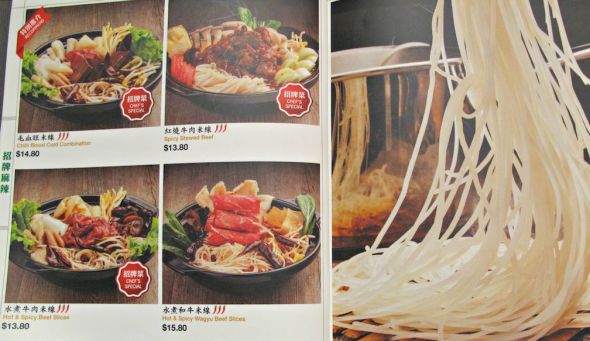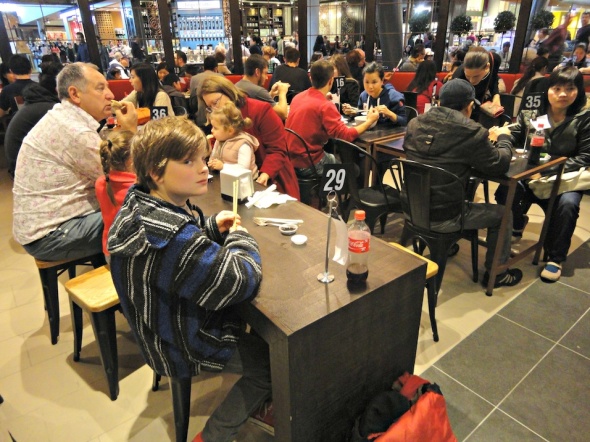
Part of the current cooling system at Highpoint shopping centre.
Coming from a mechanical engineering and airconditioning background, centre manager Scott Crellin is happy to confess that the Highpoint cooling system is his kind of “thing”. He says that while the existing system is about 15 years old, it’s still significantly more efficient than rows of single-unit rooftop units, as still seen in many smaller and older shopping centres. He tells me the system servicing the $300 million extensions will be significantly better again.
Western suburbs musicians and artists – Scott Crellin is interested in hearing from you.
Scott is centre manager of Highpoint.
His phone number is 9319 3320.
This invitation comes near the end of a wide-ranging conversation I have with Scott and centre development manager Mark Pheely.
While they have stressed at every opportunity the commitment of the centre and parent company GPT to community engagement and sustainability, they are happy to confess they are largely unaware of the depth and breadth of western suburbs arts culture and that there is plenty of scope for new ideas and new people.
“We’d love to be looking at more live performance events,” Mark says.
Our meeting is the result of a letter I sent to Highpoint lamenting the colossal wastage inherent in centre food courts’ use of plastic cutlery and crockery.
Scott, as centre manager, sent a nice reply detailing the centre’s efforts to be good guys and issuing an invitation of a meeting and tour.

Centre manager Scott Crellin and development manager Mark Pheely with the Highpoint development plans.
Of course, no amount of sincere talking or a close-up look at the inner workings of the centre are ever likely to turn myself or anyone else – including several Consider The Sauce visitors who posted rather caustic comments – into paid-up members of the Highpoint fan club.
Nevertheless, I enjoy hearing the two men talk about the challenges the centre faces and their pride in working for GPT.
I may never be an outright Highpoint lover, but it is a significant institution in my community, one that won’t go away if I pretend it isn’t there.
And my engagement with Highpoint could well go deeper if some of the many musicians I know live in the west were to start providing some cool sounds there and gain some paying work in the process.
How about a Highpoint Music Festival?
For many people, I suspect that what they tell me will fall firmly into the “Well, they would say that, wouldn’t they?” category. But all I can do is report what I am told.
I am fascinated talking to these two blokes about their work and the often competing demands – consumer, shareholder, legislative – they confront on an almost daily basis.
They both firmly believe their company is far advanced in terms of sustainability of rivals such as Westfield.

The Highpoint development project.
Regarding the existing centre, they find themselves mostly looking at areas where they can have an impact in an establishment that has been around since the mid-’70s and a business that was formulated many decades ago when cars were big, petrol was cheap and recycling was unheard of.
They feel hampered, too, by the absence of local recycling infrastructure.
Regarding the specific issue of plastic implements and plates in the food courts, I put to them a question posted by Consider The Sauce visitor Janet: Have they done both a life-cycle analysis and a benefit-cost analysis of real crockery and collective washing?
The answer is yes – about five or six years ago.
At that time such a move was deemed unviable but they concede that perhaps it’s time to address the issue again.
As with so many other things – car safety and pharmaceuticals, for instance – it seems the existence of technology and processes is by itself not sufficient. The tipping point only comes when a move forward becomes firmly viable and, indeed, necessary in a business sense.
“There are limits to what we can do,” Mark says. “The Trade Practices Act means we can’t actually force tenants to use proper crockery. The tenants that do so, that’s their decision.
“A change like this would involve decisions about who pays. And with the fast-food market being super price sensitive, the difference between a $10 meal and a $11.50 meal is really significant.”
Centre management has some oversight jurisdiction over menus, but other than that the individual food court tenants run their own businesses as they see fit.
I am a little surprised and somewhat heartened to learn that despite the “same-iness” of food offerings from centre to centre, almost no pre-prepared food is brought in to Highpoint.
I tell them that from a perception point of view, the departure of Borders and Angus & Robertson has made – for myself and many others – Highpoint seem like a much more unpleasant place.
(There is, by the way, a new but very small bookshop called The Last Page in the same wing as Target.)
They rue the departure of Borders, but rightly say it was out of their hands.
They concede, too, that any replacement on a significant scale is unlikely given the turbulence the publishing industry is experiencing.

As in hospitals and the like, the lines are used to delineate different kinds of recycling.

Highpoint is one of about 18 centres run by GPT around Australia.
On site there 30 or so GPT staff, about 300 service staff covering areas such as security, cleaning, pest control and landscaping. The centre has about 400 stores.
A $300 million development project is currently underway.
This will see stores under the David Jones and Woolworths banners, 100 more individual traders and extra parking for 100 cars.
Stage 1 – comprising a full-line Woolworth’s supermarket, Fresh Food Market, community spaces and carparking with Park Assist technology – is scheduled for completion late this year.
Stage 2 – two-level David Jones, 100 retailers including premium fashion, children’s precinct and 1000 new car spaces – is scheduled for completion in early 2013.

Development manager Mark becomes noticeably more animated when talking about the opportunities presented by the new project.
He says that on every level – electricity usage, recycling, airconditioning and ventilation, lighting and more – the new development will be a vast improvement on the existing structures.
A customer survey discovered that overwhelmingly people want the new developments to be something that “reflects the west”.
To that end, Mark is overseeing the use of more natural materials, including bluestone, timber, artwork and furnishings.

I finish my Highpoint visit with a Highpoint lunch – non-plastic variety, of course – before elbowing a couple of kids aside to have my photo taken with Homer.















































































